The Future of Food: Sustainable Global Solutions for a Growing World
Food is one of the most important parts of our lives. It connects people, fuels our bodies, and shapes cultures. But as the world’s population grows, the way we produce and consume food must change to ensure everyone has access to healthy meals. Right now, our food systems face big challenges. From climate change and limited natural resources to food waste and hunger, it’s clear we need smarter and more sustainable solutions to feed the world.
In this blog, we’ll explore the future of food and how new ideas, technologies, and changes in behavior could help us create a sustainable global food system.
The Challenges We Face
The world’s population is expected to reach nearly 10 billion by 2050, and feeding everyone won’t be easy. The way we produce food today has major downsides:
-
Environmental Impact: Agriculture uses up huge amounts of land, water, and energy. It’s also a leading contributor to greenhouse gas emissions, largely from animal farming and deforestation. If we continue with business as usual, the planet will struggle to support sustainable food production.
-
Food Waste: About one-third of all food produced globally is wasted. Some food goes unused due to supply chain inefficiencies, while some is thrown away by supermarkets and consumers. Food waste is not only a waste of resources but also adds to environmental pollution.
-
Hunger and Inequality: Despite producing enough food to feed everyone, millions of people, especially in poorer countries and vulnerable areas, still suffer from hunger and malnutrition. Meanwhile, others consume unhealthy amounts, contributing to obesity and related diseases.
-
Climate Change: Rising global temperatures, droughts, and unpredictable weather patterns make it harder for farmers to grow crops and raise animals. Many traditional agricultural practices may become less reliable as climates continue to shift.
Innovative Solutions for a Sustainable Future
To overcome these challenges, scientists, farmers, companies, and governments are working together to rethink the future of food. The goal is to create systems that are good for people, the planet, and future generations. Let’s explore some of the game-changing ideas and technologies shaping this future.
1. Plant-Based and Lab-Grown Proteins
Meat production takes up a lot of land and water while releasing large amounts of greenhouse gases. A shift toward plant-based alternatives, like tofu, beans, and meat substitutes made from soy or pea protein, is already underway. Many companies are also experimenting with lab-grown meat, which is real animal protein produced in laboratories without the need to raise or slaughter animals. These options could reduce the environmental impact of traditional animal farming.
2. Vertical Farming
Imagine crops growing in tall buildings with rows of plants stacked on top of each other. Vertical farming uses less space and requires fewer resources, like soil and water. These indoor farms are controlled environments that can produce food year-round, regardless of weather conditions. This approach is ideal for crowded urban areas where farmland is scarce.
3. Regenerative Agriculture
Regenerative agriculture focuses on farming practices that restore soil health and biodiversity instead of harming it. Farmers using this method plant cover crops, reduce chemical use, and rotate crops to improve soil fertility. These techniques help sequester carbon, reduce erosion, and create a healthier long-term food system.
4. Ocean Farming
Our oceans hold great potential for food production. Seaweed and algae farming are becoming more popular because they require little space, don’t need freshwater, and absorb carbon dioxide as they grow. Sustainable fish farming or aquaculture is another area of interest in ensuring seafood remains available without damaging marine ecosystems.
5. Smart Technology
Technology plays a big role in modern agriculture. Drones, sensors, and artificial intelligence (AI) help farmers monitor crops and livestock more efficiently, saving time and resources. Precision farming, where resources like water and fertilizer are applied exactly where they’re needed, reduces waste and improves yields.
6. Reducing Food Waste
Solving food waste is essential to the future of food. Businesses and governments are developing better ways to store, transport, and distribute food, ensuring less of it goes to waste. Consumers, too, can play a role by being mindful of their purchases and using leftovers creatively.
Global Collaboration for a Better Future
Creating a sustainable food system isn’t just about technology—it requires global cooperation. Governments need to support policies that encourage sustainable farming practices. Companies should invest in eco-friendly solutions, while individuals can make responsible choices, like eating less meat, diversifying their diets, and reducing their food waste. Educational campaigns can also help people understand the connections between their food choices and the environment.
International organizations like the United Nations are already working on ambitious programs like the Sustainable Development Goals (SDGs), which aim to tackle hunger, inequality, and climate change by 2030. Collaboration between countries will be important to address the challenges of feeding growing populations.
A Future of Hope
The future of food might look very different from what we’re used to. From lab-grown burgers to farms in cities, we’re stepping into a new era of innovation. While the challenges are serious, the solutions are promising. What matters most is that we all take part in this transformation—whether it’s through our daily food choices, supporting sustainable businesses, or spreading awareness about the importance of changing our food systems.
We all share this planet and rely on its resources. By prioritizing sustainable practices, working together, and embracing new ideas, we can build a future where food is accessible, healthy, and environmentally friendly for everyone. Let’s make that future possible, one bite at a time.


